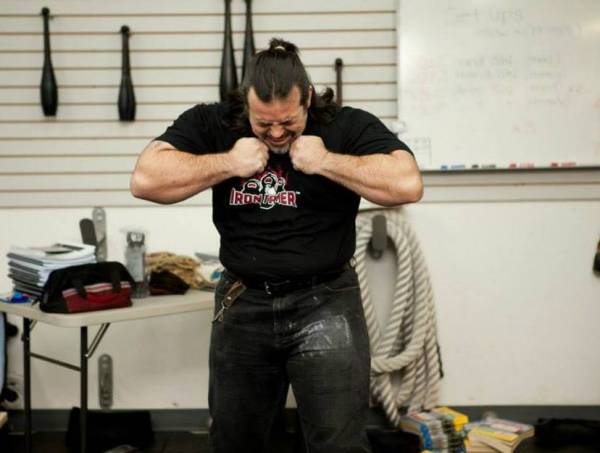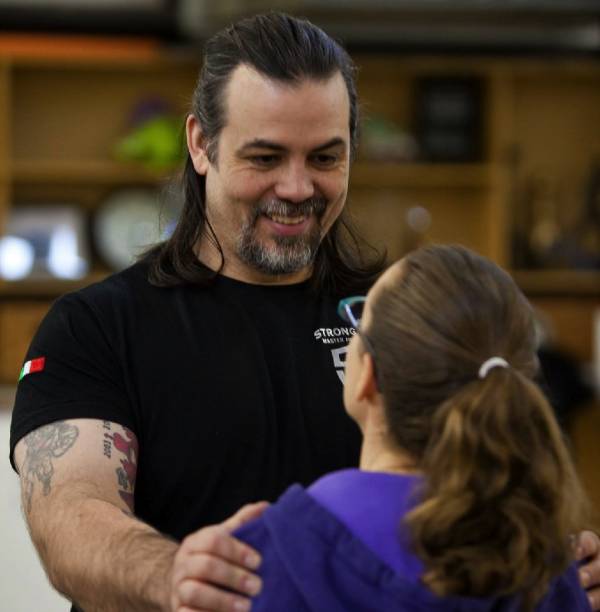In this second part of my interview with Dave “The Iron Tamer” Whitley, he shares tips on utilizing all available strength through power breathing and the right mix of tension and relaxation. He also provides an outstanding definition of good form and how to put things overhead.
At one point in our discussion, Dave quoted his colleague Jon Engum, who once told him, “The secret to happiness in life is to put heavy stuff over your head.” So let’s get to creating happiness.
The Importance of Tension
Tension has three important purposes:
- First, it allows you to create a solid base in order to transfer force from the ground into the object we are lifting. If we strict press overhead and our body is like a noodle, it will be tough to transfer the weight overhead (plus, it will be quite unsafe).
- The second purpose of tension is to inhibit signals from the brain that protect us from hurting ourselves. These stay-safe signals are inhibited by the feed-forward signals that are generating tension. If you have heard the stories of people picking up cars to save their children, their safety signals are being inhibited through maximal tension.
- The third purpose is based on the Sherrington Law of Irradiation, which states that muscles working hard tend to recruit nearby muscles.1 Pavel Tsatsouline called this law “muscle cheering,” as nearby tight muscles cheer the working muscles to work harder.2
Dave Whitley added to the discussion of tension, saying:
The principles behind deadlifting a heavy barbell, pressing a heavy kettlebell, doing a one-arm pushup, or bending a horseshoe or a piece of steel, they’re all the same. They have to do with generating tension and force, directing that into the activity at hand and being able to complete that in a way that makes sense biomechanically for the individual. Safety’s built into it.
But Breathing Is Also Important
Breathing and bracing have been talked about before. However, some people accidentally imitate, but don’t actually perform the desired abdominal bracing. Dave explained:
I will see people show up at certifications doing what they think is power breathing, which is a tension generation technique designed maximize nervous system output by using a particular breathing technique. Very often, a hissing sound … is associated with that particular technique.
They’ll show up and they’ll be just weak as an undernourished kitten and trying to press something. They’re making this hissing sound and they’ll just slack all over the place. They’re missing the point. They’re making the noise, but they’re not doing the thing that they should be doing with the noise.

The hissing sound is not power breathing. The hissing sound is a byproduct of the intra-abdominal compression that goes on during a properly executed power-breathing technique. That hissing is just a bleed-off like a pressure cooker (the valve that comes open on a pressure cooker, when the pressure hits a certain point).
Dave elaborated on the difference between the act of power-breathing and the act of noise-making:
If you watch some of the guys … who’ve spent a lot of time and gotten very skilled at it, we might hold our breath or might not make any noise at all or might grunt or yell or make some other noise like that. The point of something like power breathing is generating that intra-abdominal pressure and the tension, not making the noise.
The Role of Relaxation
Tension has a counterpart that is almost as important, especially in strength endurance sports. For example, in the StrongFirst-style kettlebell swing there is a ballistic hip hinge and then there is relaxation as the kettlebell’s momentum continues upward. A person who is tense the whole time will get tired quickly. You must learn to relax when there is an opportunity. Dave described the duality of tension and relaxation:
The importance of the whole thing is to remember that, without relaxation, there can be no tension. Without tension, there can be no relaxation. The problem that I see, working with general population, is that people don’t understand how to do either one.
They walk around, half-assed, doing two things, instead of whole-ass doing one thing. … They never completely generate enough tension to maximize whatever their potential is in a particular lift … It’s a skill that has to, not only be practiced, but learned.
You have to learn a skill before you can practice it. We talk about strength as a skill and it’s a skill that needs to be practiced. It’s always a skill that has to be learned. … The skill of tension and the skill of strength are things to be learned. Relaxation is also a skill that has to be learned. There’s a lot of different ways you can do it, but you have to be able to relax mentally along with being able to relax physically.

Building a Foundation of Form
We’ve addressed three elements of lifting overhead – tension, breathing, and relaxation – but all of this should be built on a foundation of good movement. I doubt that anyone will comment saying they don’t agree with the idea that form is important. However, a definition of good form sometimes seems elusive. I think Dave provided one of the best that I have heard:
We talk all the time about how important technique and form is in a given exercise. …Who can define good form for me? …It’s so important that we don’t have a definition for it. Then it turns into one of those things like in the late ‘80s when all of the rock bands were on trial for obscenity. I don’t know what is obscene … I can’t define it but I know what it is when I see it. …
One of the best definitions that I got … was from Kirk Karwoski, the powerlifter. Kirk said that good form is biomechanically correct for the individual and aesthetically pleasing to the viewer, because he’s in the business of lifting weights for judges in powerlifting meets, right? …
I thought that that was a very good definition, but I added one thing to it to make it a little bit broader and not just meet-specific. Biomechanically correct for the individual, it’s aesthetically pleasing to the viewer, and it is appropriate to the goal of the person performing the exercise.
References:
1. Austregesilo, A. 1928. “Synreflexia (Association of Reflexes).” The Journal of Nervous and Mental Disease 68 (1): 1–10.
2. Tsatsouline, Pavel. 2000. Power to the People!: Russian Strength Training Secrets for Every American. Dragon Door Publications.






